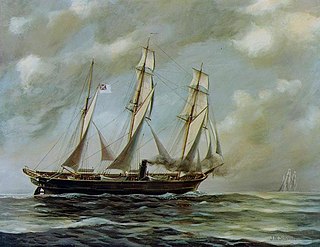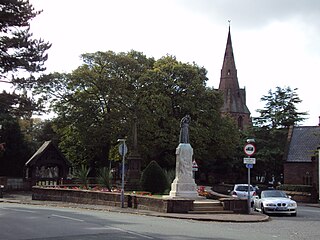
PS Lelia was a steamship built in 1864, [1] during the American Civil War for use as a blockade runner for the Confederate States of America. She sank in Liverpool Bay in 1865 in an incident that caused 46 fatalities.

PS Lelia was a steamship built in 1864, [1] during the American Civil War for use as a blockade runner for the Confederate States of America. She sank in Liverpool Bay in 1865 in an incident that caused 46 fatalities.

Lelia was built by William C Miller & Company of Toxteth as one of a trio of blockade running sister ships ordered for the Anglo-Confederate concern, William G. Crenshaw & Company. She was a 252-foot (77 m) paddle steamship of 640 BRT. Her hull was built of steel, an unusual and expensive material for shipbuilding at the time. The engines and other machinery were built by Fawcett Preston & Company and rated at 300 nhp. (The Confederate States Navy warship, CSS Florida, had also been built at Miller's yard.)
She left the River Mersey, with a largely Liverpool-based crew, and several prominent Confederate naval officers, on her maiden voyage on 14 January 1865 bound for Wilmington, North Carolina, via Bermuda, aiming to run the Union blockade.
Lelia was heavily laden, and when she hit bad weather off the coast of North Wales, large waves knocked her anchors loose and through the deck, swamping her. She sank near the lightship Prince off the Great Orme.
Two boats were able to leave the stricken ship, but one capsized and only twelve survivors (out of fifty-one on board) reached the safety of the lightship.
The next day the Liverpool No 1 Lifeboat went to the scene under tow by the steam tug Blazer, but was itself swamped by waves, with the loss of seven out of its 11 crew. [2]
The wreck of Lelia was discovered in the early 1990s when a diver recovered a bell from the seabed inscribed 'Lelia 1864'. [3] It lies 10 miles north west off Hilbre Point, Wirral. The remains include one of the paddle wheels, the engine and boiler rooms, as well as less well-preserved cargo areas and a steam winch. The wreck was given protected status when it was added to the National Heritage list for England by the Department for Digital, Culture, Media and Sport in August 2019. [1]

The Mersey Ferry is a ferry service operating on the River Mersey in north west England, between Liverpool to the east and Birkenhead and Wallasey on the Wirral Peninsula to the west. Ferries have been used on this route since at least the 12th century, and continue to be popular for both local people and visitors.

Birkenhead is a town in the Metropolitan Borough of Wirral, Merseyside, England; historically, it was part of Cheshire until 1974. The town is on the Wirral Peninsula, along the west bank of the River Mersey, opposite Liverpool. At the 2011 census, it had a population of 88,818.

The Confederate States Navy (CSN) was the naval branch of the Confederate States Armed Forces, established by an act of the Confederate States Congress on February 21, 1861. It was responsible for Confederate naval operations during the American Civil War against the United States's Union Navy.

CSS Alabama, a screw sloop-of-war built in 1862 for the Confederate States Navy. The vessel was built in Birkenhead on the River Mersey opposite Liverpool, England, by John Laird Sons and Company. Launched as Enrica, she was fitted out as a cruiser and commissioned as CSS Alabama on August 24, 1862. Under Captain Raphael Semmes, Alabama served as a successful commerce raider, attacking, capturing, and burning Union merchant and naval ships in the North Atlantic, as well as intercepting American grain ships bound for Europe. The Alabama continued its wrath through the West Indies and further into the East Indies, destroying over seven ships before returning to Europe. On June 11, 1864, the Alabama arrived at Cherbourg, France, where she was overhauled. Shortly after. A Union sloop-of-war, USS Kearsarge, arrived; and on June 19, the Battle of Cherbourg commenced outside the port of Cherbourg, France, whereby the Kearsarge sank the Alabama in approximately one hour after the Alabama's opening shot.

Eastham is a village and an electoral ward of the Metropolitan Borough of Wirral, in Merseyside, England. Historically, it was part of Cheshire. It is situated on the Wirral Peninsula, to the south of Bromborough and to the east of Willaston.
Merseytravel is the passenger transport executive, responsible for the coordination of public transport in the Liverpool City Region in North West England. Merseytravel was established on 1 December 1969 as the Merseyside Passenger Transport Executive. From 1 April 2014, with the creation of the Liverpool City Region, Merseytravel expanded its area of operation from the metropolitan county of Merseyside to also include the Borough of Halton.

Princess Royal was a British merchant ship and blockade runner that became a cruiser in the Union Navy during the American Civil War and later returned to civilian service.

CSS Robert E. Lee was a fast paddle-steamer, originally built as a Glasgow-Belfast packet boat named Giraffe, which was bought as a blockade runner for the Confederate States during the American Civil War, then subsequently served in the United States Navy as USS Fort Donelson and in the Chilean Navy as Concepción.

Wallasey is a town in the Metropolitan Borough of Wirral, Merseyside, England. Within the boundaries of the historic county of Cheshire, it is at the mouth of the River Mersey, on the north-eastern corner of the Wirral Peninsula. At the 2011 Census, the population was 60,284.

Birkenhead Priory is in Priory Street, Birkenhead, Merseyside, England. It is the oldest standing building on Merseyside. The site comprises the medieval remains of the priory itself, the priory chapter house, and the remains of St Marys church. All three are recorded in the National Heritage List for England, though at different grades.

The Wirral line is one of two commuter rail routes operated by Merseyrail and centred on Merseyside, England, the other being the Northern line.

Woodside is an area of Birkenhead in the Metropolitan Borough of Wirral in Merseyside, England. It is situated opposite Liverpool Pier Head across the River Mersey.

The Williamson Art Gallery and Museum is an art gallery and museum situated in Birkenhead, Merseyside, England and houses Wirral's art collection.
The Georgiana was a brig-rigged, iron hulled, propeller steamer belonging to the Confederate States Navy during the American Civil War. Reputedly intended to become the "most powerful" cruiser in the Confederate fleet once her guns were mounted, she was never used in battle. On her maiden voyage from Scotland, where she was built, she encountered Union Navy ships engaged in a blockade of Charleston, South Carolina, and was heavily damaged before being scuttled by her captain. The wreck was discovered in 1965 and lies in the shallow waters of Charleston's harbor.

USS Bienville was a 1,558 long tons (1,583 t) (burden) wooden side-wheel paddle steamer acquired by the Union Navy early in the American Civil War. She was armed with heavy guns and assigned to the Union blockade of the waterways of the Confederate States of America.

The first USS Wando was a steamer captured by the Union Navy during the American Civil War. In commission from 1864 to 1865, she was used by the United States Navy as a gunboat in support of the Union Navy blockade of Confederate waterways.

SS (RMS) Mona (II) No. 76302 was a packet steamer operated by the Isle of Man Steam Packet Company. Mona was the first screw-driven ship in the company's history.

During the American Civil War, blockade runners were used to get supplies through the Union blockade of the Confederate States of America that extended some 3,500 miles (5,600 km) along the Atlantic and Gulf of Mexico coastlines and the lower Mississippi River. The Confederacy had little industrial capability and could not indigenously produce the quantity of arms and other supplies needed to fight against the Union. To meet this need, numerous blockade runners were constructed in the British Isles and were used to import the guns, ordnance and other supplies that the Confederacy desperately needed, in exchange for cotton that the British textile industry needed greatly. To penetrate the blockade, these relatively lightweight shallow draft ships, mostly built in British shipyards and specially designed for speed, but not suited for transporting large quantities of cotton, had to cruise undetected, usually at night, through the Union blockade. The typical blockade runners were privately owned vessels often operating with a letter of marque issued by the Confederate government. If spotted, the blockade runners would attempt to outmaneuver or simply outrun any Union Navy warships on blockade patrol, often successfully.
William Fawcett was an engineer and manufacturer of guns and steam engines, supplying steam engines for some of the earliest steam ships in Britain and America, and for use on sugar plantations in America. He was a partner in the firm of Fawcett, Preston and Company, which supplied the steam engines for a number of ships, including the paddle steamer William Fawcett, described as the first ship operated by what would become the Peninsular and Oriental Steam Navigation Company (P&O).
The remains of the ship were discovered in the Liverpool bay area in the 1990s when a bell marked 'Lelia 1864' was found by a local diver.